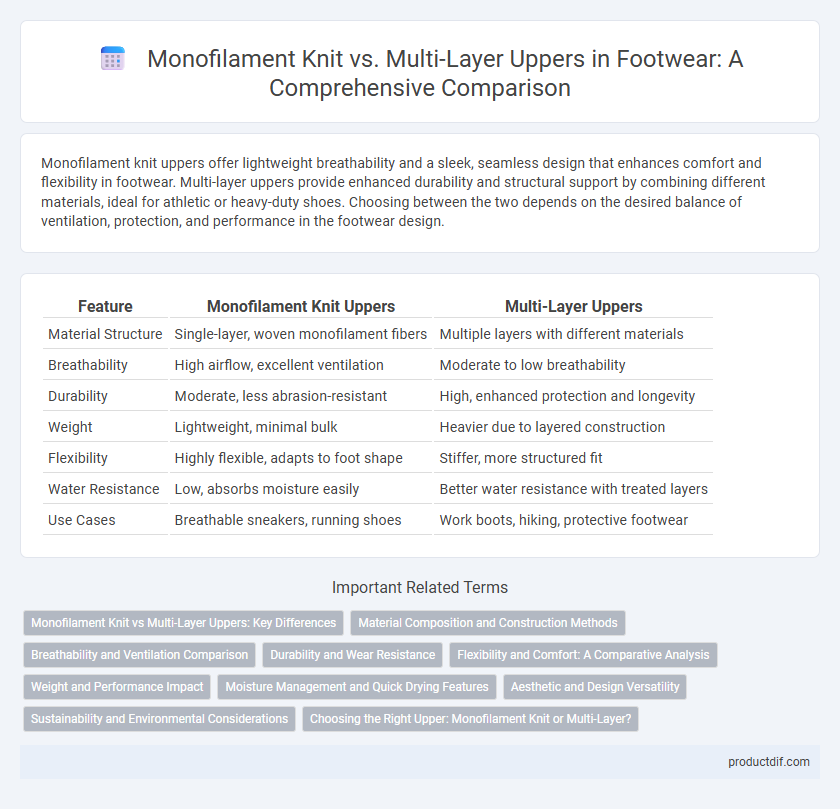Monofilament knit uppers offer lightweight breathability and a sleek, seamless design that enhances comfort and flexibility in footwear. Multi-layer uppers provide enhanced durability and structural support by combining different materials, ideal for athletic or heavy-duty shoes. Choosing between the two depends on the desired balance of ventilation, protection, and performance in the footwear design.
Table of Comparison
| Feature | Monofilament Knit Uppers | Multi-Layer Uppers |
|---|---|---|
| Material Structure | Single-layer, woven monofilament fibers | Multiple layers with different materials |
| Breathability | High airflow, excellent ventilation | Moderate to low breathability |
| Durability | Moderate, less abrasion-resistant | High, enhanced protection and longevity |
| Weight | Lightweight, minimal bulk | Heavier due to layered construction |
| Flexibility | Highly flexible, adapts to foot shape | Stiffer, more structured fit |
| Water Resistance | Low, absorbs moisture easily | Better water resistance with treated layers |
| Use Cases | Breathable sneakers, running shoes | Work boots, hiking, protective footwear |
Monofilament Knit vs Multi-Layer Uppers: Key Differences
Monofilament knit uppers use a single, continuous strand of yarn that offers lightweight breathability and flexibility, enhancing comfort and airflow in footwear. Multi-layer uppers consist of several stacked materials, providing increased durability, support, and protection against wear and tear. Choosing between monofilament knit and multi-layer uppers depends on the desired balance between lightweight ventilation and structural reinforcement in shoe design.
Material Composition and Construction Methods
Monofilament knit uppers utilize a single continuous filament yarn, creating a lightweight, breathable, and flexible structure ideal for performance footwear. Multi-layer uppers combine different materials such as mesh, synthetic leather, and TPU overlays through stitching, welding, or adhesive bonding, providing enhanced durability, support, and weather resistance. The choice between monofilament knit and multi-layer uppers significantly impacts comfort, ventilation, and structural integrity in modern shoe design.
Breathability and Ventilation Comparison
Monofilament knit uppers feature a single layer of tightly knit fibers, offering exceptional breathability due to their lightweight and highly porous structure that promotes efficient air circulation. Multi-layer uppers, while providing enhanced durability and support, often compromise ventilation as the additional layers reduce airflow and trap heat inside the shoe. For optimal foot comfort in warm conditions, monofilament knit uppers outperform multi-layer designs by maintaining superior breathability and quicker moisture evaporation.
Durability and Wear Resistance
Monofilament knit uppers offer superior breathability and lightweight comfort but generally lack the durability and wear resistance found in multi-layer uppers. Multi-layer uppers, composed of several reinforced materials, provide enhanced abrasion resistance and structural support, making them ideal for high-impact activities and extended wear. The layered construction in multi-layer uppers effectively protects against tearing and deformation, ensuring longer-lasting footwear performance.
Flexibility and Comfort: A Comparative Analysis
Monofilament knit uppers offer superior flexibility due to their single-layer, seamless construction, allowing the shoe to adapt more naturally to foot movements, which enhances overall comfort. In contrast, multi-layer uppers provide increased durability and support but often sacrifice flexibility, potentially leading to a stiffer fit that can reduce comfort during extended wear. Choosing between monofilament knit and multi-layer uppers depends on the balance of flexibility and support desired for specific activities or foot needs.
Weight and Performance Impact
Monofilament knit uppers deliver exceptional lightweight performance, reducing overall shoe weight and enhancing speed and agility during athletic activities. Multi-layer uppers provide superior durability and structural support but often add cumulative weight, potentially impacting endurance and energy efficiency. Choosing between monofilament knit and multi-layer uppers depends on prioritizing minimal weight for rapid movement or enhanced protection for prolonged use.
Moisture Management and Quick Drying Features
Monofilament knit uppers excel in moisture management due to their single-layer, breathable structure that rapidly wicks sweat away from the foot, enabling quick drying and enhancing comfort during prolonged wear. Multi-layer uppers, while offering additional support and durability, can trap moisture between layers, potentially slowing drying times and reducing breathability. Advanced monofilament designs leverage open knit patterns and hydrophobic fibers to optimize airflow and evaporation, making them superior for moisture control and quick drying in active footwear.
Aesthetic and Design Versatility
Monofilament knit uppers provide sleek, seamless aesthetics that enable intricate patterns and vibrant color gradients, enhancing modern footwear designs. Multi-layer uppers offer superior structural support and can combine various materials for textured, dynamic looks ideal for performance-driven styles. Design versatility increases with monofilament knit through lightweight customization, while multi-layer constructions excel in durability and multifunctional design applications.
Sustainability and Environmental Considerations
Monofilament knit uppers offer enhanced sustainability by utilizing a single type of recyclable material, reducing waste and simplifying recycling processes compared to multi-layer uppers composed of varied materials. Multi-layer uppers often involve complex adhesives and composites, which hinder biodegradability and increase the carbon footprint during production and disposal stages. Choosing monofilament knit construction supports circularity initiatives in footwear manufacturing, aligning with eco-friendly practices and lowering overall environmental impact.
Choosing the Right Upper: Monofilament Knit or Multi-Layer?
Monofilament knit uppers offer enhanced breathability and lightweight flexibility, ideal for activities requiring dynamic movement and ventilation. Multi-layer uppers provide superior durability, structural support, and protection, making them suitable for demanding terrains and prolonged wear. Selecting the right upper depends on balancing factors such as intended use, climate conditions, and performance requirements to optimize comfort and functionality.
Monofilament knit vs Multi-layer uppers Infographic

 productdif.com
productdif.com